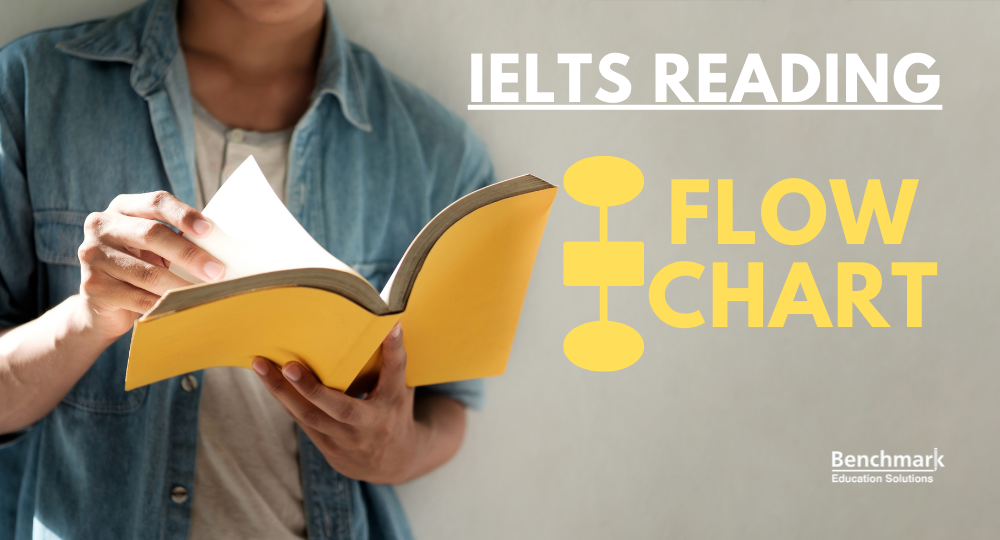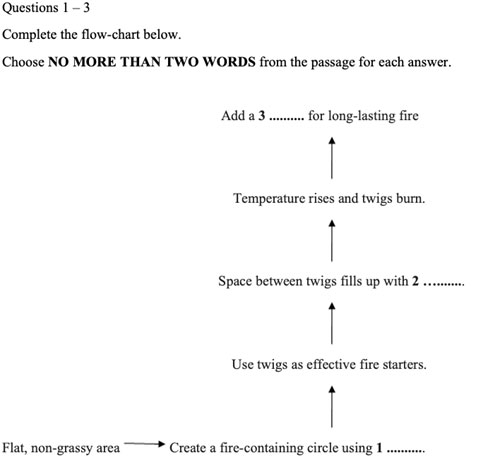

In IELTS reading section, flow-chart questions may be challenging to tackle due to their presentation, and the need for candidates to understand the order of information. Test takers need to scan for specific words from the text to use as answers which can seem a little tricky to some. Do not worry, Benchmark IELTS has got you covered with helpful tips and tricks, as well as example questions to help you!
Table of Contents
1. Overview
The Flow-chart question type is one of fourteen (14) question types on the Reading Section of the IELTS exam.
- Objective: You must identify words in the text to use as answers in a flow chart.
- Skills Used: You will need to skim and scan the text for specific information. You should ensure you understand the order of information so you can choose the words within the text to use as your answer.
The question will be a flow-chart. An IELTS reading flow chart is a visual way to describe the order in which the stages of a certain process take place. The flow chart will contain short key phrases and arrows which will help you understand the order of stages being described in the text, and the direction in which the information is going. Some key phrases in the flow-chart will contain gaps which you will need to fill in using words taken from the text. You will need to paraphrase the key words in the short phrases, which will help you locate the information in the text
If you feel the need for extra practice in completing this task, continue reading for tips and our sample test!
Check out our article with an overview of all the Reading question types on the IELTS exam!
2. Example of Flow Chart Completion Question
This is how the question will appear on your question paper



3. Steps to Follow
How should you answer IELTS reading questions that require you to complete the flow-chart? Follow our steps below!
3.1. Read the Instructions Carefully.
The instructions in this task will tell you how many words you may choose from the text to use as your answer. You may use from 1 word up to the maximum number of words indicated in the instructions. For instance, if the instructions say up to 3 words, you may use 1, 2 or 3 words, but no more than 3.
3.2. Read and Understand the Phrases in the Flowchart
Due to the nature of flow-charts and how they are comprised of small phrases and arrows, it is important to make sure you understand what the topic of the flow-chart is, and its key phrases.
Because you are looking for specific information in the text, and answers do not come in order, it is essential that you read the key phrases carefully and understand what they mean. Ask yourself what is the key information you are required to find? For instance, if the phrase says ‘drop in amount of oxygen in blood due to ___’, you will then need to look for information about a decrease in oxygen in the text. Once you have done that, you may choose which word(s) should fill that gap.
3.3. Paraphrase the Phrases:
Paraphrasing the questions means saying what they mean in different words, focusing particularly on key words or phrases:
Example:
‘Drop in amount of oxygen in blood due to _____’ In other words: ‘Decrease in quantity of oxygen in the blood because of _____’
If you explain the questions in other words, you make sure you understand them better, and you can see more easily where the meaning is expressed in the text.
3.4. Understand the Order of Information in the Flow-chart
Using the arrows, make sure you understand the stages being described in the flow-chart. Understanding the stages is key to identifying them in written form in the text, and finding the answers.
3.5. Skim the Text
To skim the text means to read it quickly to get the general idea. This is a good way to familiarise yourself with the content, since you will need to find specific information in the text. Especially for a task that requires an understanding of the order of information, reading the text quickly should help you notice certain words that might be helpful when looking for answers in the text. This will also give you a broad idea about the nature of information in each paragraph, thereby helping locate the rest of the information, as well.
3.6. Scan the Text for Information
To scan a text means to read it quickly while looking for specific information. You don’t need to read or understand every single word, as long as you are able to identify specific information that helps you answer the question, including synonyms to key words you have paraphrased.
3.7. Choose the Correct Answer
3. Tips & Tricks
3.1 You must read the instructions carefully. They will tell you the maximum number of words to use in your answers.
3.2 Read all the key phrases in the flow chart before reading the text. Because the answers do not come in order, you want to make sure you know what specific information you are expected to look for in the text before answering the questions. This will help you make the most of your time.
3.3 When paraphrasing the key phrases, think of synonyms to key words and/or phrases in the phrases:
Example:
‘raindrops are absorbed into the soil’
raindrop = rainwater
absorbed = soaked up, taken in
soil = ground, earth
3.4 The advantage of skimming the text is that scanning becomes easier, as you are familiar with the content. Lack of order for the answers location means you may need to go back and forth in the text. Skimming the text will help reduce the time you spend scanning the text for information
3.5 You may even attempt this question type after you have answered the rest of the questions in the passage. This should give you sufficient insight into the passage and you’ll be able to find the relevant location with ease.
5. Mock Test
The Science of Campfires
When we imagine a campfire, we tend to picture big logs and tall, warm flames. But how do these flames come to be? Some might attempt to start a fire with big logs, assuming that their size would guarantee that of the flames. What they will notice, however, is that the flames struggle to catch onto the log. The use of small twigs, on the other hand, will lead to a stable fire upon which campers can build, by adding gradually bigger pieces of wood. Let’s look at the science behind such phenomenon.
If we take a small twig and light it up, we will notice that it will burn faster that a larger log, partially because it is smaller in size, and therefore requires less energy to raise its temperature for it to burn. By burning a pile of twigs, we can ensure a steady level of heat, which will allow us to add larger pieces of wood to the mix. Once those have reached the necessary temperature, we may eventually add logs.
Size is but one reason why smaller twigs should be the starting point of a campfire. There is also the matter of oxygen. Fire grows with the presence of oxygen, and diminishes with lack thereof. The space available between the pieces of wood in a pile of twigs will allow ample presence of oxygen. With one large log, there is very little space for oxygen to roam inside it, as it is filled with wood. Therefore, the fire will have more room to grow and expand amongst the twigs than inside the log.
Large logs may not be as efficient for burning, but that, too, can be an advantage. Once you get your fire going with smaller pieces of wood, you want to make sure it lasts, so you can warm up and prepare your food. Because small twigs burn so well, the fire will be consumed too quickly without the support of a large log. Its size and lack of space for oxygen is exactly what makes it perfect for slowing down the burning of the fire.
What is also important to remember for a successful campfire are the optimal conditions in which it should take place. You should look for a flat location, exposed to dirt. Avoid grassy areas or spaces with dead grass. If that is not an option, you may dig the ground to remove a layer of grass. Make sure you start your campfire as far away as possible from any items, plants or tree that could catch on fire. Surrounding your campfire with rocks to create a circular enclosed space that would help contain the fire is highly recommended. Make sure, however, that you leave a little space between the rocks to allow a good flow of oxygen.









